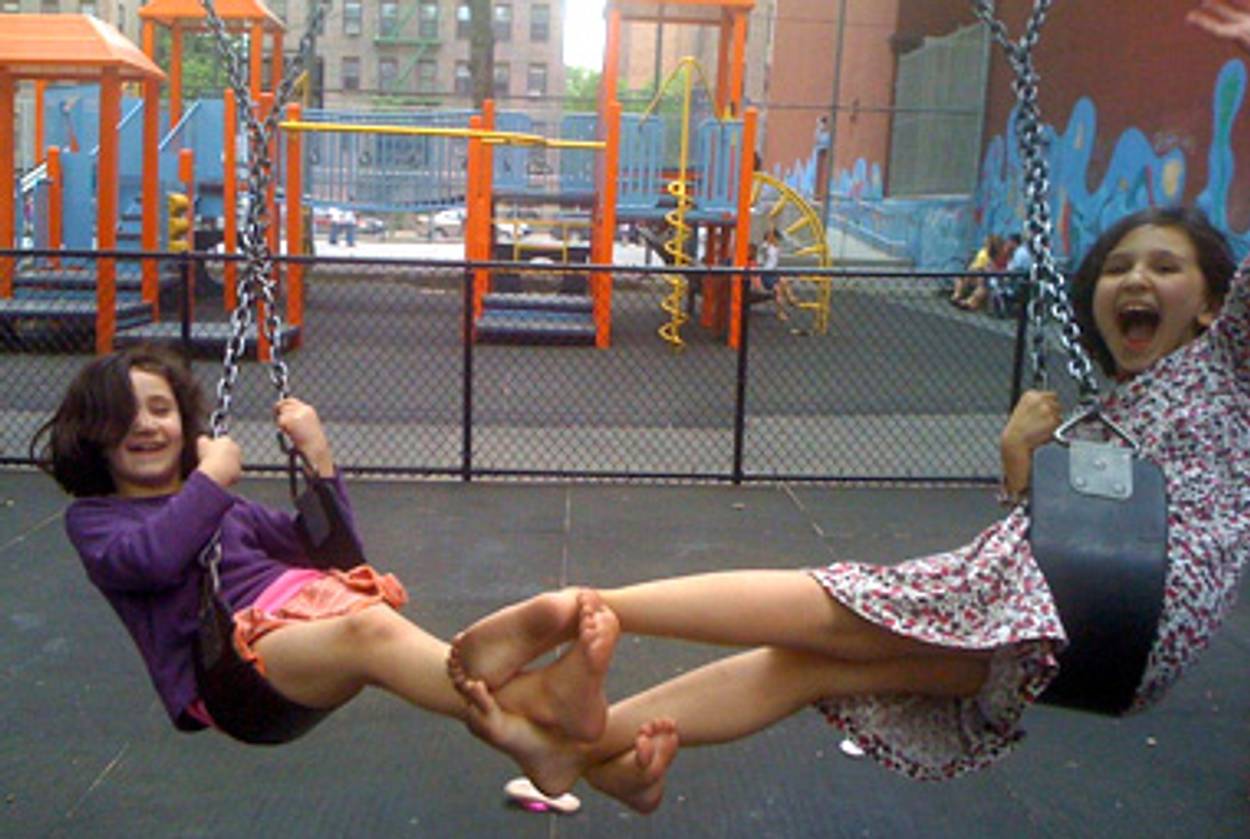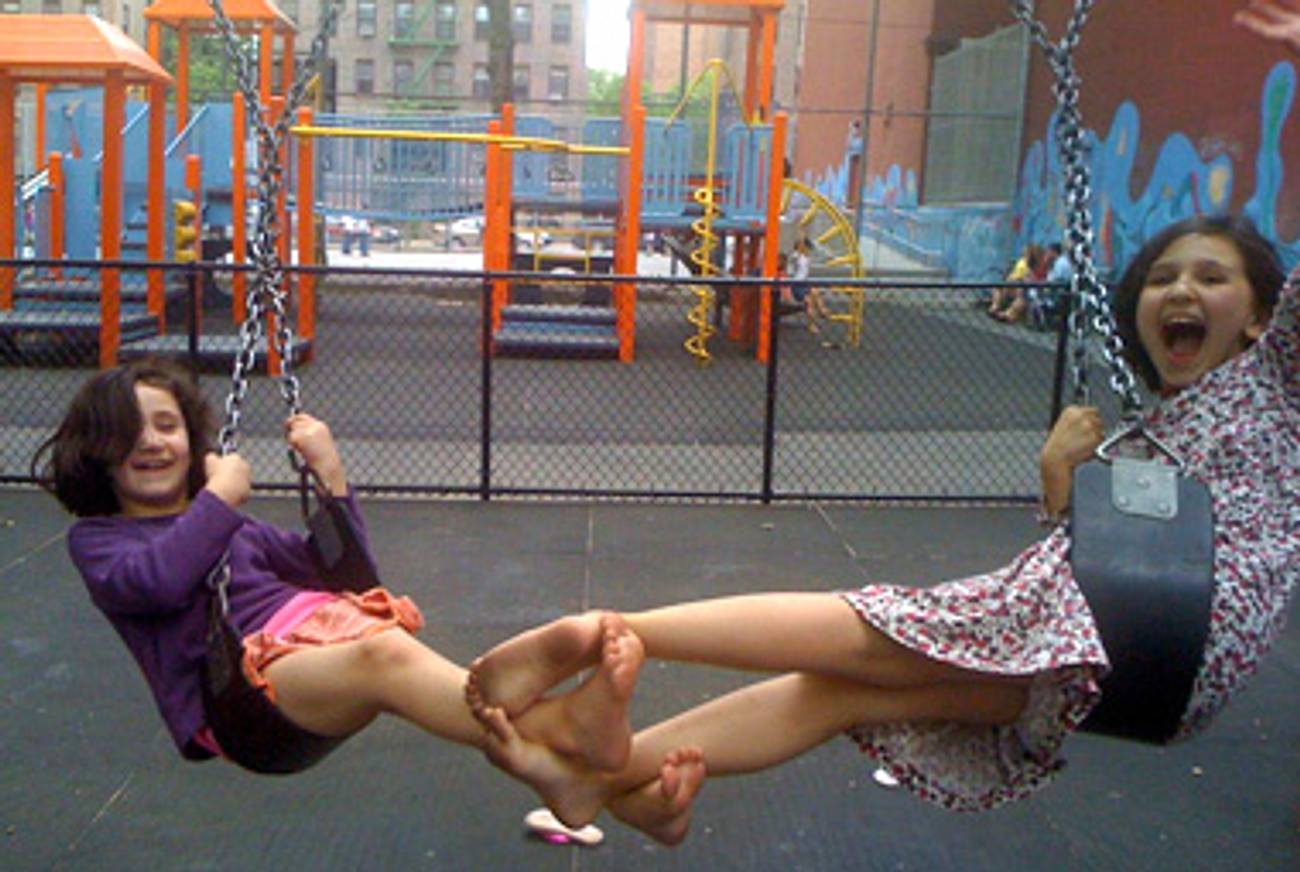In With the In Crowd
‘Inclusive’ education—when special-needs students share classrooms with other students—benefits all kids




As I write this, kids are going back to school almost everywhere but in New York City. The first day of school isn’t until September 8 here, and thanks to Rosh Hashanah, our second day isn’t until September 13. I think our last day of school this year will be around Tisha B’Av.
Something else is different for my kids this year: They’ll both be in inclusion classes. “Inclusion” is when students with special educational needs spend all or most of their class time with non-disabled students. My kids’ public school is starting “collaborative team teaching” classes for the first time—that’s when a special-education teacher and a general-education teacher work together with one class that combines both populations.
Maxie is one of the kids with special needs. She has motor, speech, and other challenges. Josie, on the other hand, could read young-adult novels in second grade and scores sky-high in standard measures of achievement. I think they’re both brilliant (and beautiful and hilarious, and here, let me show you our vacation slides), but they learn in very different ways. And I think this model of education is going to work beautifully for both of them.
There’s been a seismic shift in the way public schools approach kids with special needs in New York City. In the past, most were shunted off to self-contained special-ed classes. Kids with less severe learning issues were helped using a “pull out, push in” model, in which a learning specialist takes the kid out of class for a while or shadows them in the classroom, quietly helping. This method, of course, means that a kid misses out on a lot of classroom life. Maxie had pull-out-push-in assistance last year. I predict that collaborative team teaching will help her feel a greater sense of community.
Private schools have historically been a lot less interested in kids with special needs. Many still counsel out kids who need extra help or tell parents to pay for specialists’ services on their own, and if the kid can’t keep up, too bad. Sadly, this has also described Jewish day schools and synagogue Hebrew schools.
I recently chatted with Dori Frumin Kirshner, the executive director of Matan (the name means “gift”), an organization that supports Jewish communities in educating children with special learning needs.
“The Orthodox have always taken on responsibility for educating all Jews,” she told me. “But Conservative, Reform, unaffiliated, and non-denominational institutions—well, the going attitude was, ‘Sorry, we can’t handle that. Bye. It’s not you; it’s us.’ The latent message, of course, was, ‘It’s you.’ ”
Things are slowly changing. More Jewish organizations are calling Matan for help, and a number of Jewish day schools are trying to be more embracing of kids with learning differences. “There’s a big difference from 10 years ago,” Kirshner said. “But it still takes time, attitude change, and advocacy. Clergy, early-childhood, and educational directors, the president of the shul, they need to step up more and take the full responsibility off parents’ shoulders. This is everyone’s bag. It’s a health and human services issue, an educational issue, and a cultural issue—because there are so many kids out there with no entry points to the beauty of Jewish culture.”
Inclusion, Kirshner said, was a policy equal in importance to the civil rights movement. “You don’t have to be from the South or African-American to feel in your kishkes that it’s wrong to leave children separate,” she said. “I feel strongly—just as my mom, a white Jew who grew up in Shreveport and marched and got arrested for civil rights felt—this is wrong. It’s wrong to tell people there’s no room for them at the Jewish communal table. They have to start adding other chairs.”
Of course, inclusion—in both secular and Jewish settings—isn’t easy. It takes teachers who recognize different learning styles and plan for them. It calls for professional development for teachers—general and special educators alike—to help work out how best to foster cooperative learning and peer tutoring. It requires smaller class sizes.
And most of all, it needs a schoolwide commitment to true diversity and community. “There’s a social benefit to discovering that everyone has strengths,” said my kids’ principal. “It’s important to be able to work with different kinds of people, to care for people who are different from you, and to see school—and life—as more than just a rat race and a competition. We had a kid with autism in one class who had an incredible instinct for spelling and grammar. He was the best grammarian in the class, and kids really gravitated to him for that and then found other commonalities.”
My kids’ school has a leg up in introducing inclusion classes because it already has mixed-age classrooms. Teachers are accustomed to multilevel instructional approaches and individualized education. Maxie will be in a 1st-2nd grade inclusion class, and Josie will be in a 4th-5th grade inclusion class. I hope collaborative team teaching will help Maxie with her special needs and help Josie with hers (namely impatience, hyper-competitiveness, bossiness).
My mom, a professor of Jewish education, laughs at how many parents, when considering Jewish day schools for their kids, only want to know what high schools or colleges the graduates get into. (Of course, this is true at non-Jewish schools too.) It can be a lot harder to convince competitive upper-middle-class parents that inclusive education can be good for their precious, advanced little flower.
But it really can be. Even “gifted” kids can benefit. “Done well, inclusive education taps into the depth a kid is capable of,” my girls’ principal said. “Many gifted programs simply offer accelerated learning from a grade level or two up. But keeping curriculum across the grades open and wide-ranging means that every kid can reach the heights he or she is capable of.” One kid may be just learning spelling, while another is writing a novel, and good teachers help both. “There’s a saying,” says the principal: “Good special-ed teaching is good teaching.”
Too often, unfortunately, “gifted” education brings to mind the following story: A guy runs to his rabbi yelling, “Rabbi! Rabbi! I learned the whole Torah by heart!” The rabbi replies, “And how much of it penetrated your heart?” In other words, it’s not only the acquisition of knowledge we should be concerned with. It’s g’milut chasadim, too—kindness, mutual support, and solidarity.
There are times when inclusion isn’t appropriate. “Learning Hebrew or tfilot can work better in a self-contained setting,” said Kirshner. “For instance, if a kid has serious ADHD or Tourette’s in addition to a spectrum disorder. And sometimes parents of kids in mainstreamed classes will tell me no one ever invites them for a play date. A self-contained class can be a meaningful social setting.”
Gifted kids are special-needs kids too; they also benefit from special enrichment. But, Kirshner warns, “ ‘gifted education’ shouldn’t universally be the way your kid learns.” Inclusivity, done right, is beneficial to all students. And, as I said, it’s not easy.
But I’m confident that Josie and Maxie’s school is ready. Pairs of special-ed and general-ed teachers have spent the summer doing professional development and learning the most effective classroom set-up, structures, and pedagogy. I’m hopeful. And as Kirshner puts it, “We’re all gonna have a special need sometime. We may lose our hearing; we may break a leg. By engendering the values of inclusion, the fact that we all have something to contribute, we create a better world.”
Marjorie Ingall is a columnist for Tablet Magazine, and author of Mamaleh Knows Best: What Jewish Mothers Do to Raise Successful, Creative, Empathetic, Independent Children.
Marjorie Ingall is a former columnist for Tablet, the author of Mamaleh Knows Best, and a frequent contributor to the New York Times Book Review.